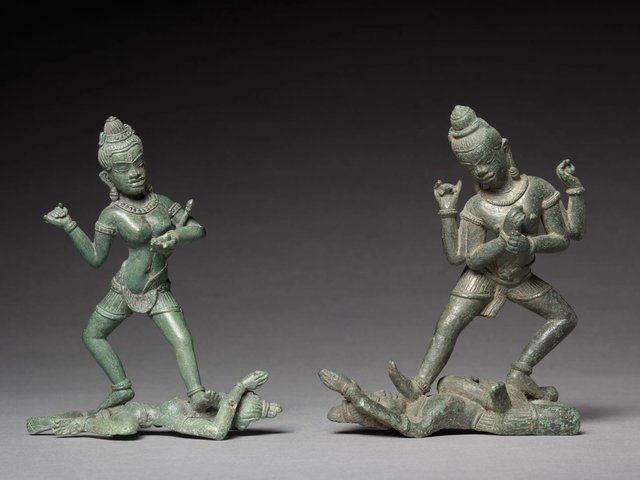An eleventh-century statue of the four-headed Brahma, sold by Sotheby’s in London on 21 October 1993 for £2,070 has been proven to be looted from Angkor.
A photo of the head is included on page 92 of the book One hundred missing objects: looting in Angkor, published by the International Council of Museums (ICOM) in September 1993. The sculpture sold at Sotheby’s has been formally identified as the same object by Elisabeth Desportes, ICOM’s secretary general, and Bruno Dagens, professor at the University of Paris III and expert at the Ecole française d’Extrême-Orient, co-producers of the Angkor book.
Following a visit by Mr Dagens to Sotheby’s on 14 November, Mrs Desportes has written to the auction house to express her hope that it will be returned. According to Mrs Desportes the Cambodian ambassador in London will be bringing a complaint in the near future.
This is not the first such discovery made by ICOM. In a sale of Indian and south-east Asian art held by Sotheby’s New York on 2 June 1992. Lot 96, a torso of the goddess Khmer in the Baphuon style of the eleventh century, was sold for $63,250 against an estimate of $30,000-50,000 to a Swiss gallery. ICOM has lost trace of it, but according to Elisabeth Desportes, Interpol are pursuing their own investigations.
Responding to The Art Newspaper, Sotheby’s issued a statement which reads: “At Sotheby’s we make every effort to discover the origins of the objects which are offered for sale. We do not hesitate to act in these sorts of cases. Our expert received the ICOM book after the sale of the 21 October 1993. He acted immediately and at his insistence the sale of the head was cancelled. We made contact with ICOM and invited them to inspect the object. Following the visit of their experts on 14 November we have been waiting for official confirmation”.
Perhaps even more surprising is the presence of another object illustrated in the book (page 80) which is now in the Metropolitan Museum, New York. This is a head of Siva from the early tenth century. It had been removed from a sculpture of the god in the temple of Phnom Krom at Angkor. The Met informed ICOM that they have it.
Another ICOM publication has provided damning information about an African statuette sold by Paris auctioneer Loudmer on 5 December 1992 and before that by him in 1989. Before the first sale the vendor had produced an export license which has now been declared to be false by the Ivory Coast authorities. They have now embarked on a procedure to reclaim the object, which is illustrated on page 50 of ICOM’s book One hundred lost objects: looting in Africa.
Speaking to the Art Newspaper sister paper, Le Journal des Arts, Mr Loudmer said: “We had no reason in 1989 to doubt the authenticity of the export license. How were we to know that a document which was fine in 1989 would no longer be three years later? It is up to governments to take better care of these things”.
In December 1993 the Parisian dealer Jean-Michel Beurdeley gave back a Khmer sculpture of a goddess to UNESCO’s Cambodian delegation. Mr Beurdeley had bought the sculpture in Bangkok in 1980. Realising as early as 1982 that the sculpture was looted, he says that he preferred to wait until the end of the Vietnamese occupation before handing it back.
Elisabeth Desportes has summed up the situation: “Most Khmer pieces currently on the market are of doubtful origins. Our aim is to give back all such objects unless their good provenance can be proved beyond doubt. We are absolutely not against the market but we would prefer that it be based on surer moral foundations, as well as better observing professional codes of ethics and extreme vigilance. This applies to auctioneers, dealers and collectors”.


